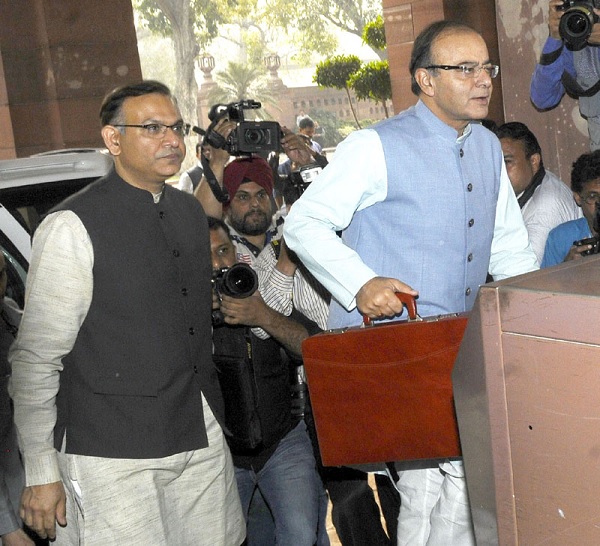
by admin | May 25, 2021 | Corporate, Corporate finance, Corporate Governance
 New Delhi : The Cabinet Committee on Economic Affairs, chaired by Prime Minister Narendra Modi, on Wednesday approved promotion of agricultural mechanisation for in-situ management of crop residue in Punjab, Haryana and Uttar Pradesh and NCT of Delhi to address air pollution in the national capital.
New Delhi : The Cabinet Committee on Economic Affairs, chaired by Prime Minister Narendra Modi, on Wednesday approved promotion of agricultural mechanisation for in-situ management of crop residue in Punjab, Haryana and Uttar Pradesh and NCT of Delhi to address air pollution in the national capital.
A new central sector scheme was proposed in this Union Budget to address air pollution with total outlay of Rs 1,151.80 crore.
Establishment of farm machinery banks for custom hiring of in-situ crop residue management machinery and financial assistance to the farmers for procurement of such machinery are major components of the scheme.
Also, mass awareness campaigns will be undertaken along with capacity building programme, advertisement in print media, star campaigning, award for village and gram panchayat for achieving zero straw burning.
—IANS

by admin | May 25, 2021 | Corporate, Corporate Governance, Economy, Finance, Investing, News, Politics
 By Archana Sharma,
By Archana Sharma,
Jaipur : The Modi health care scheme announced in the Union budget this year is quite similar to the one introduced in Rajasthan in December 2015, says Kali Charan Saraf, Rajasthan’s Minister of Health.
Under the Bhamashah Swasthya Bima Yojana (BSBY), health insurance cover of Rs 30,000 for general illnesses and Rs 3 lakh for critical illnesses is being given to beneficiaries.
An individual gets a risk cover for around 1,715 diseases and is also covered for major procedures like heart surgery and kidney transplant. Around 50 million of the state’s estimated 69 million people are said to be registered under this scheme.
The basic aim of the Bhamashah Yojana is to bring about an improvement in health indicators, reduce out-of-pocket expenses and provide financial security to the poor against illnesses, the minister told IANS. He said it is also bringing in a “revolution in healthcare” in the rural areas of the state.
On the “only difference” between the scheme implemented in the state and the one announced in the Union budget, Saraf said under the Modi health care scheme — dubbed ‘Modicare’ by a section of the media — the coverage amount had been increased to Rs 5 lakh for a family.
He says the modus operandi of the new scheme would be similar to the one being executed in Rajasthan, which covers almost two-thirds of the population of the state.
“In the last two years, we have disbursed claims worth Rs 1,000 crore,” Saraf said, adding that, till date, 1.6 million people had benefited from the scheme in urban and rural areas. “We have empanelled over 1,300 hospitals, both government and private, under the scheme,” the minister said.
Asked if the central government had held a discussion on this scheme with the state before its announcement, he said that when the Union Minister of Health and Family Welfare, J.P. Nadda, was in Rajasthan about seven months ago, “we had updated him of this scheme as it was running quite successfully in the state”.
Asked if the Rajasthan government would like to claim credit for the announcement of the central scheme, he said it was the same whether the central government was running it or the state. “It is an ambitious scheme and hence it is always good if the best things are picked up and used for the benefit of others,” he added.
On the challenges in successfully implementing the scheme, he said his team had fought initial hiccups which included the slow rate of card activation, documentation and confusion on treatment packages. “But, it is running smooth now,” he added.
Asked about the reasons for poor performance of the state government in the Niti Aayog report released recently, he said the report had taken 2014-15 figures into consideration. “We had hardly finished a year when the survey for this report was done. A year back, the state was under Congress rule and hence we can’t be blamed for a poor performance in the state,” he said.
Counting the steps his government had taken, he said that it started 581 Adarsh Primary Health Centres in Rajasthan in all panchayat samitis to receive free medicine and free health check-ups. “They do not face any trouble,” he said, adding that a Rajya Janani Yojana had been set which had resulted in a 180 per cent increase in successful deliveries in the state.
(Archana Sharma can be contacted at arachana.g@gmail.com)
—IANS

by admin | May 25, 2021 | Business, Large Enterprise, Medium Enterprise
 New Delhi : Industry body Assocham on Wednesday recommended a weighted tax deduction of 150-200 per cent on actual cost of specified components for the consumer electronics sector in the upcoming Union Budget.
New Delhi : Industry body Assocham on Wednesday recommended a weighted tax deduction of 150-200 per cent on actual cost of specified components for the consumer electronics sector in the upcoming Union Budget.
The deduction is required as costs pertaining to finance, energy and logistics/transportation constitute a major portion of consumer electronics sector, the chamber said in a release.
“Further, these costs are auditable and duly included in the financial statements of a company,” the release said quoting the recommendations on direct tax made by the body to the centre.
With a view to revive private investments in the electronics sector, Assocham has suggested that venture capital pool may be introduced in the sector and coordinated by a bank/special purpose vehicle or under public-private partnership mode, according to the release.
“In order to boost the availability of capital funds to India’s $100 billion worth electronics industry, it is imperative that a venture capital pool be created and allied tax incentive provided to enable genuine private players to use funds of such pool through a stringent mechanism,” said D.S. Rawat, Secretary General, Assocham.
Contributors may be offered tax incentives on the dividend, while manufacturers may be provided with tax exemptions, it said.
To make the business more competitive in the electronics sector, Assocham has recommended the government to link the India BPO Promotion Scheme with direct tax benefit.
—IANS

by admin | May 25, 2021 | Corporate, Corporate Governance, Finance, News
 Mumbai:(IANS) Union Budget announcements, combined with negative Asian cues, and a dip in the rupee value depressed the Indian equity markets during the afternoon trade session on Monday.
Mumbai:(IANS) Union Budget announcements, combined with negative Asian cues, and a dip in the rupee value depressed the Indian equity markets during the afternoon trade session on Monday.
Consequently, the barometer 30-scrip sensitive index (Sensex) of the Bombay Stock Exchange (BSE) plunged by over 151 points.
Similarly, the wider 50-scrip Nifty of the National Stock Exchange (NSE) traded in the red. It was lower by 62 points or 0.88 percent to 6,968.15 points.
The Sensex, which opened at 23,238.50 points, traded at 23,002.77 points (at 12.00 p.m.) — down 151.53 points or 0.65 percent from the previous day’s close at 23,154.30 points.
During the intra-day trade so far, the Sensex touched a high of 23,293.80 points and a low of 22,956.80 points.
Vaibhav Agarwal, vice president and research head at Angel Broking, elaborated that markets traded on a negative note, led by mixed Asian cues and cautiousness prevailing around the budget.
“Expectations continue to remain low with markets not having witnessed any pre-budget rally this year.”
Nitasha Shankar, senior vice president for research with YES Securities said: “Markets eagerly watch out for an increased spending in the infrastructure space, road map to bank recapitalisation and a rural thrust.”
“Along with this it will be crucial for the finance minister to strike a right balance between growth and fiscal consolidation.”
The Union Minister for Finance, Corporate Affairs and Information & Broadcasting, Arun Jaitley departs from North Block to Parliament House along with the Minister of State for Finance,Jayant Sinha to present the General Budget 2016-17, in New Delhi on February 29, 2016.

 New Delhi : The Cabinet Committee on Economic Affairs, chaired by Prime Minister Narendra Modi, on Wednesday approved promotion of agricultural mechanisation for in-situ management of crop residue in Punjab, Haryana and Uttar Pradesh and NCT of Delhi to address air pollution in the national capital.
New Delhi : The Cabinet Committee on Economic Affairs, chaired by Prime Minister Narendra Modi, on Wednesday approved promotion of agricultural mechanisation for in-situ management of crop residue in Punjab, Haryana and Uttar Pradesh and NCT of Delhi to address air pollution in the national capital.


